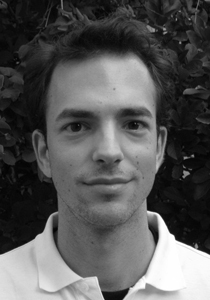Citation
The Greeley Early Career Award is named for pioneering planetary scientist Ronald Greeley. Ron was involved in nearly every major planetary mission from the 1970s until his death and was extraordinarily active in service to the planetary science community. Ron’s greatest legacies, however, are those he mentored through the decades, and it is young scientists whose work and promise we seek to recognize.
This year’s Greeley Award winner is Ian Garrick-Bethell, an assistant professor at the University of California, Santa Cruz. Ian received his Ph.D. from the Massachusetts Institute of Technology in 2009, working with Maria Zuber and doing a second project with Ben Weiss, and moved afterward to a postdoc at Brown University.
Ian began by studying the long-wavelength topography and the inertial moments of the Moon. Ian first suggested that the Moon might not have spent its orbital evolution in a circular, synchronous orbit but may have moved through other orbital configurations, including a 3:2 spin orbit resonance. Ian went on to show that the Moon’s fossil shape is consistent with being a tidal-rotational bulge that formed when the Moon was at 32 Earth radii. Ian’s first lunar work was published in Science.
Ian then worked with Ben Weiss to use modern techniques to investigate the source of remanent magnetism in some lunar rocks. The resulting paper, also published in Science, provided the first convincing evidence of an ancient core dynamo on the Moon. Now, Ian is the principal investigator on a Discovery mission proposal to investigate the high-albedo swirls visible on the Moon’s surface, which he suggests are caused by locally strong crustal magnetic fields.
It’s often said that the difficult part of science is not finding answers, but asking the right questions. Ian has the gift of asking the big questions. Congratulations to Ian Garrick-Bethell, the 2015 recipient of the Ronald Greeley Early Career Award in Planetary Science.
—Linda T. Elkins-Tanton, Arizona State University, Tempe
Response
I am deeply honored to receive the Ronald Greeley Award this year. Ron’s interest in the Moon at the start of his career is particularly inspiring to me, as I have also started my career studying the Moon. Ron eventually contributed to the study of many solar system objects, and I hope my research may eventually have the same reach.
I would like to acknowledge the tremendous support I’ve had from my Ph.D. advisers, Maria Zuber and Benjamin Weiss. I am very grateful for their roles in my career. I’d also like to acknowledge and thank my outstanding postdoc advisers, Carle Pieters and Jim Head. Many thanks to the support from NASA Ames Research Center in developing mission concepts with me, especially with the assistance of Pete Worden and Belgacem Jaroux. I’d like to thank Bob Lin for his early enthusiasm for many of these concepts. I’d also like to acknowledge my Korean collaborators, who I have enjoyed working with enormously, particularly Ho Jin and Dong-Hun Lee. Also, I am deeply indebted to the work of my graduate and undergraduate students. Finally, I’d also like to acknowledge the essential support from my friends and family.
—Ian Garrick-Bethell, University of California, Santa Cruz
Citation: AGU (2015), Garrick-Bethell receives 2015 Ronald Greeley Early Career Award in Planetary Science, Eos, 96, doi:10.1029/2015EO035927. Published on 24 September 2015.
Text © 2015. The authors. CC BY-NC 3.0
Except where otherwise noted, images are subject to copyright. Any reuse without express permission from the copyright owner is prohibited.

